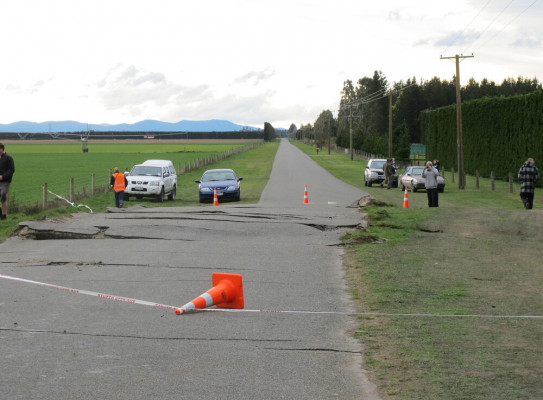Canterbury quake the most damaging since 1931

The magnitude 7.1 earthquake that hit Canterbury early today is expected to be the most damaging since the 1931 magnitude 7.8 Hawke's Bay earthquake.
The earthquake, which jolted Cantabrians awake at 4.35am on Saturday, was located 30km west of Christchurch near Darfield at a depth of 10km. It was felt throughout the South Island and as far north as New Plymouth. Damage to buildings and infrastructure in Christchurch and surrounding areas is considerable.
Dozens of aftershocks occurred in the first few hours after the quake and it is likely they will continue for weeks.
GNS Science duty seismologist, John Ristau, said typically the largest aftershocks occurred within the first 48 hours of a large earthquake. They generally declined in frequency and size over time.

A rule of thumb for a large earthquake at a shallow depth such as this is that the largest aftershock will be about one unit of magnitude lower than the main shock.
Seismologists say a foreshock of about magnitude 5.4 occurred a few seconds before the main shock. Both shocks occurred in slightly different locations. Seismic energy from the two shocks became entangled making it difficult to pinpoint the size, location, and depth of the main shock.
There are several known active faults under the Canterbury Plains and in the Canterbury foothills, but at this stage it appears the earthquake has not occurred on a known fault.
Scientists from GNS Science, Victoria University of Wellington and Stanford University in the US have joined colleagues from Canterbury University to deploy about 40 portable earthquake instruments to record aftershocks over the next few weeks.
The GNS Science contingent hopes to have most of their portable instruments deployed around Canterbury by Sunday night. This will mean approaching landowners and seeking permission, as they hope to place some of the instruments on private land.
They will concentrate their deployment on the areas where most of the aftershocks have already occurred.
The battery-powered instruments will be left unattended for about three weeks to record aftershocks. Seismologists study aftershock sequences to find out more about the mechanics of the main shock and rupture, and to ascertain if stress in the earth's crust has been transferred onto other faults in the region.
Scientists will also study satellite data to investigate surface deformation in Canterbury as a result of the earthquake. Geologists from GNS Science have travelled to Canterbury to investigate the geological and environmental impacts of the quake, and to undertake a detailed ground study.
Engineering seismologists from GNS Science will join colleagues from the Building Research Association of NZ and Canterbury and Auckland Universities to investigate the impacts on buildings and infrastructure in Canterbury to find out how different construction types performed.
The information they gather will be fed into the engineering community to help ensure structures are built appropriately to cope with stresses caused by strong ground shaking. It will also help as older buildings and structures are retro-fitted to improve their ability to withstand earthquake shaking.
Much of the scientific response to the earthquake is being coordinated under the GNS Science-led Natural Hazards Research Platform, set up by the government a year ago to provide long-term funding for natural hazards research.
Manager of the Platform, Kelvin Berryman, said post-earthquake reconnaissance was one of the roles of the Platform, as well as developing quantitative estimates of earthquake, volcano, landslide, tsunami, flood, snow, and wind hazards in New Zealand.
We have an obligation to learn as much as we can from this event to help improve our understanding of earthquakes and their impact on society, and to help ensure that New Zealand is well prepared for future earthquakes.